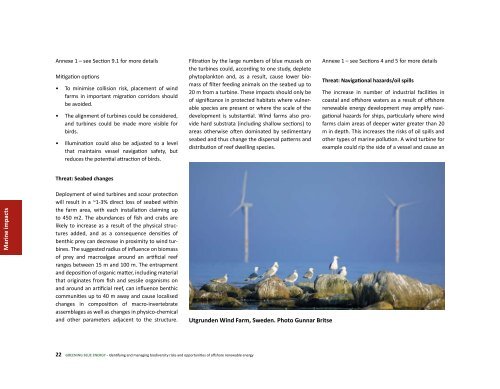Greening Blue Energy - BioTools For Business
Greening Blue Energy - BioTools For Business
Greening Blue Energy - BioTools For Business
Create successful ePaper yourself
Turn your PDF publications into a flip-book with our unique Google optimized e-Paper software.
Marine impacts<br />
Annexe 1 – see Section 9.1 for more details<br />
Mitigation options<br />
• To minimise collision risk, placement of wind<br />
farms in important migration corridors should<br />
be avoided.<br />
• The alignment of turbines could be considered,<br />
and turbines could be made more visible for<br />
birds.<br />
• Illumination could also be adjusted to a level<br />
that maintains vessel navigation safety, but<br />
reduces the potential attraction of birds.<br />
Threat: Seabed changes<br />
Deployment of wind turbines and scour protection<br />
will result in a ~1-3% direct loss of seabed within<br />
the farm area, with each installation claiming up<br />
to 450 m2. The abundances of fish and crabs are<br />
likely to increase as a result of the physical structures<br />
added, and as a consequence densities of<br />
benthic prey can decrease in proximity to wind turbines.<br />
The suggested radius of influence on biomass<br />
of prey and macroalgae around an artificial reef<br />
ranges between 15 m and 100 m. The entrapment<br />
and deposition of organic matter, including material<br />
that originates from fish and sessile organisms on<br />
and around an artificial reef, can influence benthic<br />
communities up to 40 m away and cause localised<br />
changes in composition of macro-invertebrate<br />
assemblages as well as changes in physico-chemical<br />
and other parameters adjacent to the structure.<br />
Filtration by the large numbers of blue mussels on<br />
the turbines could, according to one study, deplete<br />
phytoplankton and, as a result, cause lower biomass<br />
of filter feeding animals on the seabed up to<br />
20 m from a turbine. These impacts should only be<br />
of significance in protected habitats where vulnerable<br />
species are present or where the scale of the<br />
development is substantial. Wind farms also provide<br />
hard substrata (including shallow sections) to<br />
areas otherwise often dominated by sedimentary<br />
seabed and thus change the dispersal patterns and<br />
distribution of reef dwelling species.<br />
22 GREENING BLUE ENERGY - Identifying and managing biodiversity risks and opportunities of offshore renewable energy<br />
Utgrunden Wind Farm, Sweden. Photo Gunnar Britse<br />
Annexe 1 – see Sections 4 and 5 for more details<br />
Threat: Navigational hazards/oil spills<br />
The increase in number of industrial facilities in<br />
coastal and offshore waters as a result of offshore<br />
renewable energy development may amplify navigational<br />
hazards for ships, particularly where wind<br />
farms claim areas of deeper water greater than 20<br />
m in depth. This increases the risks of oil spills and<br />
other types of marine pollution. A wind turbine for<br />
example could rip the side of a vessel and cause an



